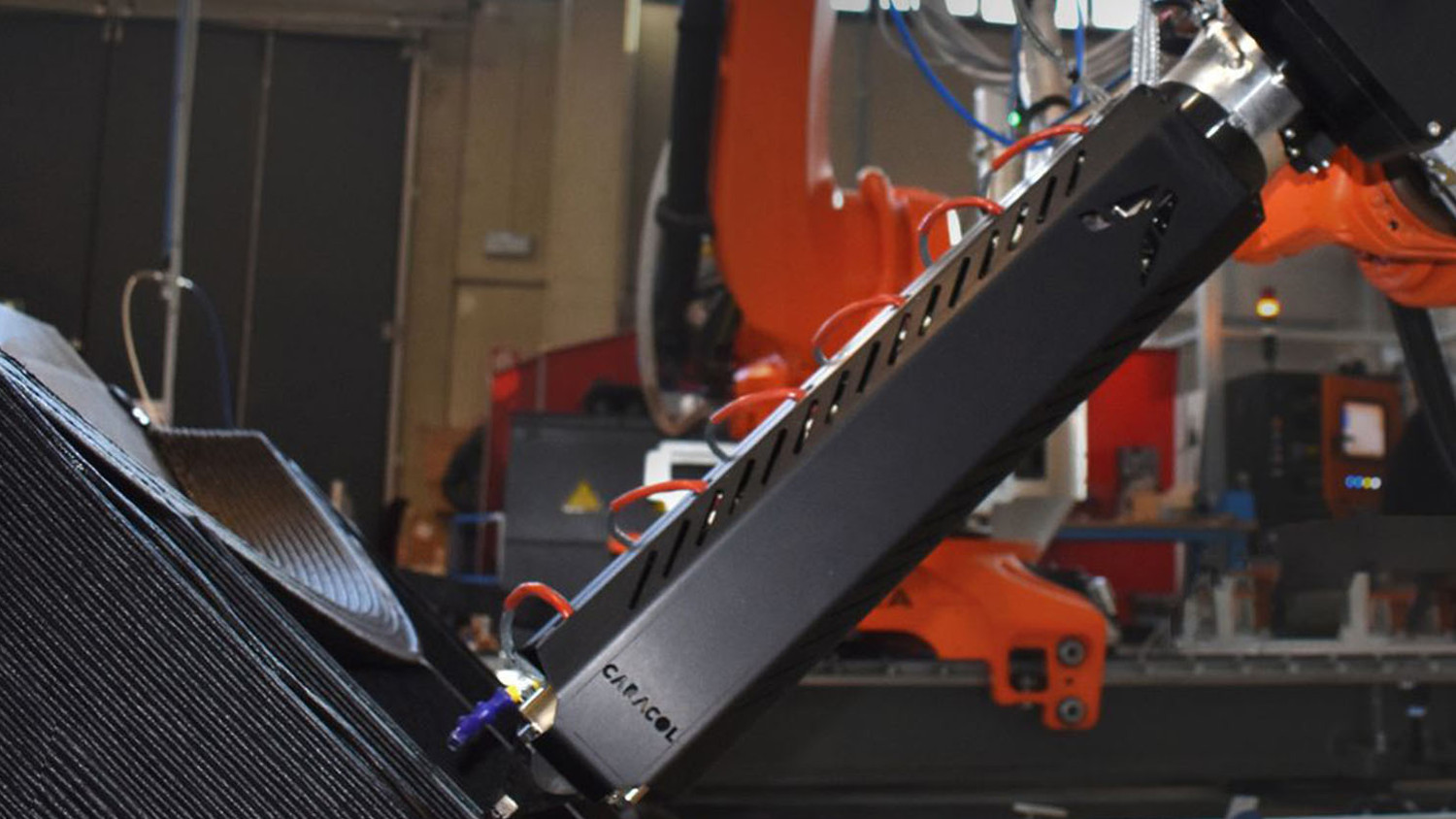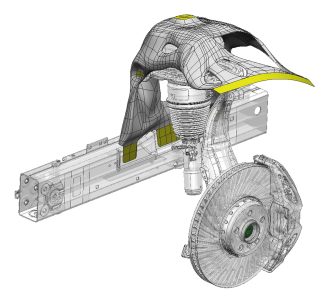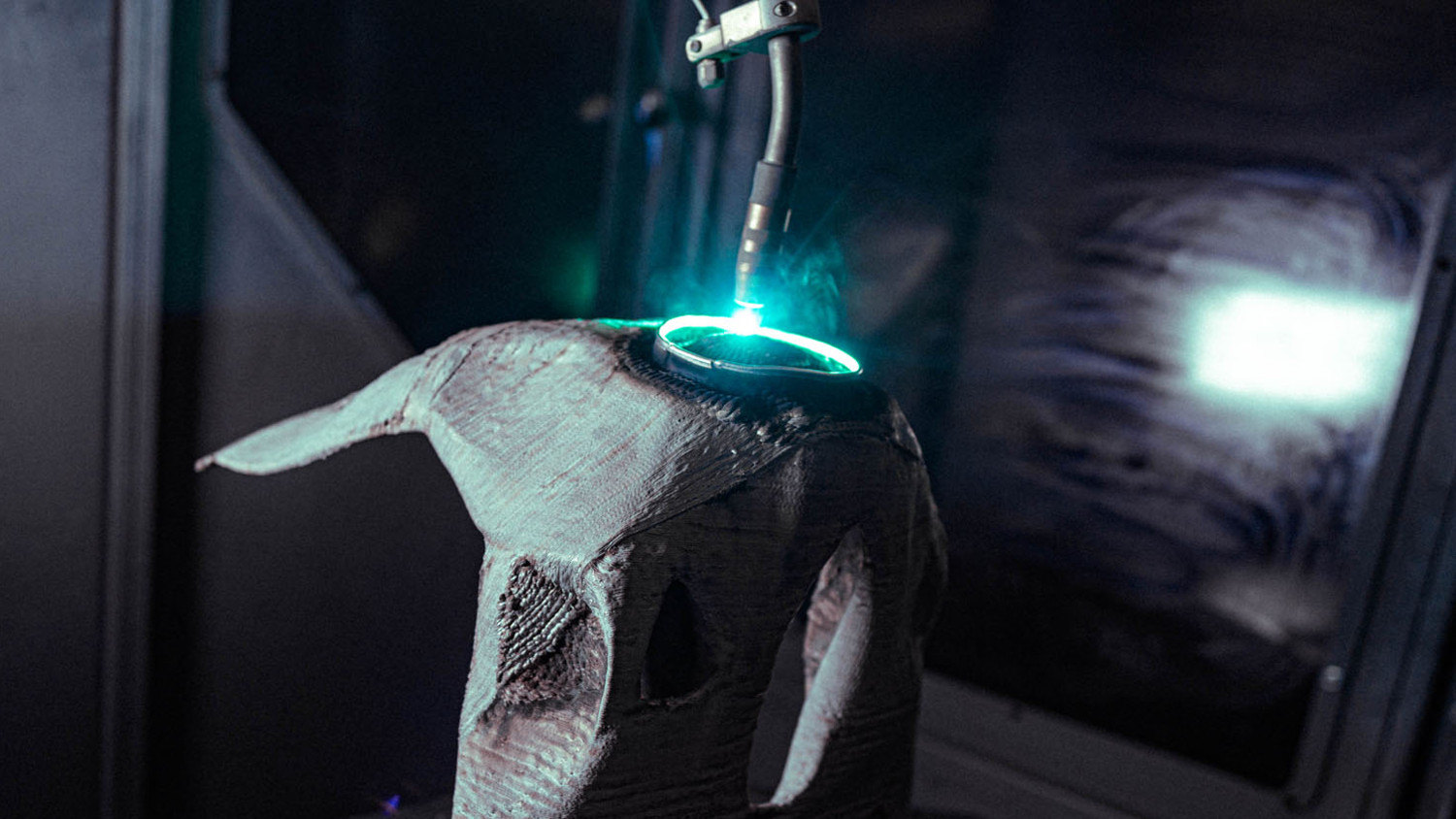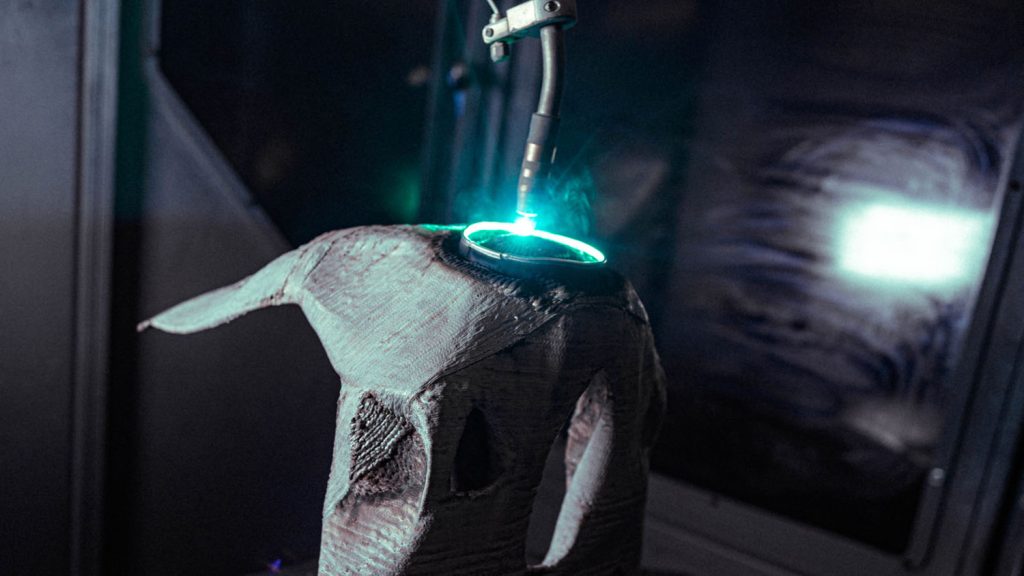Large format additive manufacturing, or LFAM, has evolved rapidly in recent years, with technologies from companies including Caracol and MX3D enabling users to take giant steps forwards, thanks in part to custom software and robotic arms equipped with printheads. DEVELOP3D spoke with executives from both companies about current use cases and smart approaches to adoption
Caracol: LFAM with polymers
Q (D3D): What would you say are the overall benefits of your company’s LFAM technology?
A (Caracol): Caracol’s Heron AM platform is a 6+ axis platform that works with pellet thermoplastic composites, from high temperature resins to recycled and bio-based options. With an average bounding box of 3 cubic metres, it can be extended to 12 cubic metres, and robotics give the ability to print multi-planar, non-planar, conformal, 45-to-60-degree printing and more.
Q: And if you had to pick out a key benefit, which one would you say best represents your company’s unique selling point?
A: Simplicity for the user. Heron AM is a turnkey solution developed following years of experience working on applications across sectors, and looks to simplify a company’s manufacturing processes providing flexibility, efficiency and sustainability.
Q: From which industry sectors are you seeing the most adoption?
A: We’re seeing systems adopted in the aerospace and automotive industries – for tooling, jigs, fixtures, moulds, mock-ups and custom parts development – and in the marine industry, where it is used for finished parts or boat hulls, prototypes and pre-series.
Q: And in which industry sectors would you say your company’s LFAM technology is having the biggest impact?
A: The biggest impact often combines benefits in terms of lead times with cost efficiencies, as well as more sustainable processes. For example, for tooling in aircraft manufacturing, LFAM can on average reduce costs by 30% and lead times by 50%, creating tools that are 50% lighter.
Q: Is Caracol attracting interest from any areas that have come as a surprise to you?
A: LFAM has gained unexpected interest in the marine and construction industries, which usually adopt very traditional and manual methods. However, the need to improve efficiency and sustainability and sometimes the safety of their highly customised production processes has driven them towards LFAM adoption.

Q: What type of robot arms does Caracol’s technology work with?
A: Heron AM can be set up with several robotic arms, such as models from Kuka, Fanuc and ABB. On average, the chosen robotic models have a reach of around 3 metres, easily extendable with booster frames or plinths, as well as with rails as additional axis. All of Caracol’s systems are supplied with enclosures, which can be either plexiglass protections, or closed rooms or enclosures to control humidity, temperature and so on. This is fundamental to guarantee safety to operators as well as for best performance.
Q: What design constraints need to be considered early on for LFAM parts?
A: LFAM means having a lot of freedom, but requires some understanding of a few key aspects. In some cases, these are like other AM technologies, and in other ways, very different. Some aspects to look into closely when designing parts include aspects like overhangs and descents, to avoid material collapse and delamination, toolpath settings, offsets and walls to ensure wall runs, support and ribs, bed positioning to avoid warping.
Q: How does your software communicate with 3D CAD packages and how do you help address issues with models in terms of editing them, building simulation and so on?
A: Caracol’s Eidos Manufacturing software suite can import standard CAD files and other formats into its libraries, analyse them with a 3D mesh editor, assess and even adjust some issues in the files. After this first check, it’s possible to set up parameters and path planning, to generate a 3D printing file. The software seamlessly integrates with Heron AM and allows users to accurately simulate the printing programme. It is possible to simulate robot kinematics, process inverse kinematics and perform collision checks and singularity analysis etcetera with an intuitive interface that clearly reports the simulation’s feedback.
Q: In your opinion, is a background in working with robotics necessary for getting the best out of LFAM?
A: A background in robotics is not needed to operate a robotic LFAM platform and Caracol provides comprehensive training, ensuring users are well-equipped to utilise the system effectively. We are seeing a lot of excellent work from customers that didn’t have any previous robotics experience. The best users usually already had some capabilities in AM, but we’ve been working well also with companies with more traditional manufacturing capabilities that are completely new to 3D printing.
Q: What would you say are some of the limiting factors of LFAM?
A: The major criteria to keep in mind are: production volumes (ideal for on-demand or small batches); geometrical complexity (difficult to obtain with traditional technology); materials (from part production to postprocessing needs); technical and mechanical requirements; technical advantages achievable (eliminating assemblies and enabling lightweight structures); supply chain and logistics (ability to localise production, print on demand, and more).
www.caracol-am.com
MX3D: LFAM with metals
(D3D): What would you say are the overall benefits of your company’s LFAM technology?
A (MX3D): Using a type of metal 3D printing called Wire Arc Additive Manufacturing (WAAM), we stand out from other AM technologies for our high deposit volume and cost effectiveness, with excellent mechanical properties. This makes MX3D’s WAAM ideal for producing large, complex metal parts – think over 5 tons and measuring over 5 metres.
Q: And if you had to pick out a key benefit, which one would you say best represents your company’s unique selling point?
A: Lead time reduction. The key reason why clients need our help is to reduce lead times compared to casting and forging processes. We sometimes reduce lead times by over a year!
Q: From which industry sectors are you seeing the most adoption?
A: The energy, maritime and aerospace sectors have lately been active in increasing their use of WAAM, due to its ability to produce large, complex metal parts meeting high-performance requirements, with great lead times. Defence and AEC are next in line.
Q: And in which industry sectors would you say your company’s LFAM technology is having the biggest impact?
A: WAAM is currently making the biggest impact in the energy industry. The technology has proven it can comply with that industry’s strict standards. Several successful pilot projects have increased the industry’s belief and appetite for WAAM. Lead time is their biggest pain and our biggest advantage.
Q: Is MX3D attracting interest from any areas that have come as a surprise to you?
A: The nuclear sector. After many years of research and convincing the market, we finally saw increased confidence in the quality of WAAM prints in recent years. Still, we were surprised by the fact that even nuclear and space are now big fans of WAAM. Those industries are risk averse – and good reasons.
The fact that these industries, based on empirical research, now invest in MX3D’s WAAM definitively proves the potential of this technology.
Q: What type of robot arms does MX3D’s technology work with?
A: Currently, we work with ABB and Kuka robots, 6-axis arms and addtional positioners. Our software workflow, however, is suitable to work with most types of industrial robots. We kept it ‘agnostic’. But as we have a small team, we try to keep hardware variables as low as possible for now.

Q: What design constraints need to be considered early on for LFAM parts?
A: General FDM printing design guidelines often apply for our technology. As mentioned, the technology works best with relatively large metal parts. We can start printing parts or segments mid-air. WAAM wall thickness typically starts at 3mm, but no maximum wall thickness applies.
We typically say that parts, especially more complex ones, need a minimum size, say, of 15cm by 15cm and more than 5kg before this technology makes sense. Furthermore, WAAM does not print large flat surfaces well, due to distortion caused by heat input. With a flat surface, we can add support ribs.
Q: How does your software communicate with 3D CAD packages and how do you help address issues with models in terms of editing them, building simulation and so on?
A: One of our differentiators is that MX3D has its own WAAM-dedicated software called MetalXL. It provides an end-to-end workflow for industrial WAAM, starting at a CAD file, creating CAM for WAAM, active control loop and all the way to a complete print report for the qualification officer. Our software signifies CAD issues. Certain CAD issues can be repaired by MetalXL, while for others, tips are given to the user to improve the file. Furthermore, the user is given a review of the WAAM printability of the part, including tips to improve this. With our partners, we are working on a beta add-on that helps with identifying and solving problematic distortions.
Q:In your opinion, is a background in working with robotics necessary for getting the best out of LFAM?
A: Surprisingly not! We solved the robotics part. It’s always an advantage, but in practice, our software and robotic systems do not require a robotics background. We provide on-site training to designers, engineers and operating teams to ensure a smooth start with WAAM technology. In our case, we advise operators who have at least basic or better welding knowledge.
Q: What would you say are some of the limiting factors of LFAM?
A: Thermal distorting from high heat might be limiting, but it is not all that serious, as users are getting around it by optimising designs to minimise heat accumulation, allowing for post-processing like machining to improve surface finish, and using advanced control systems to enhance precision and material properties.
www.mx3d.com
This article first appeared in DEVELOP3D Magazine
DEVELOP3D is a publication dedicated to product design + development, from concept to manufacture and the technologies behind it all.
To receive the physical publication or digital issue free, as well as exclusive news and offers, subscribe to DEVELOP3D Magazine here






